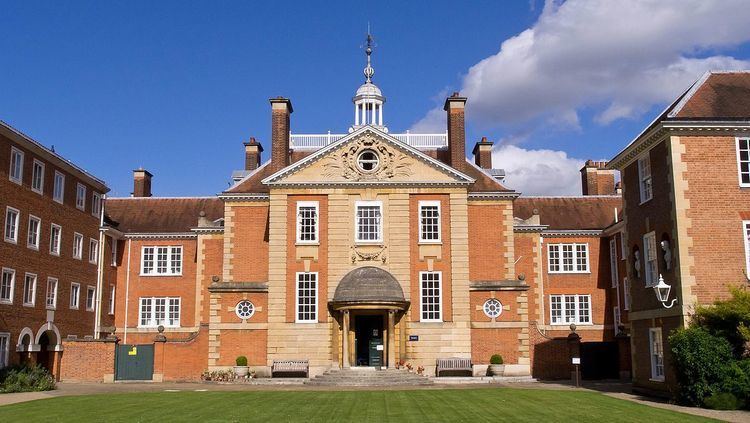Established 1878 Postgraduates 205 Undergraduate tuition and fees 7,500 GBP (2012) Phone +44 1865 274300 | Named for Lady Margaret Beaufort Undergraduates 390 (2014/2015) Website www.lmh.ox.ac.uk Total enrollment 580 (2010) Colors Yellow, White, Blue | |
 | ||
Motto Souvent me Souviens; English: I remember often (French) Notable alumni Similar University of Oxford, Christ's College - Cambridge, St John's College - Cambridge, Murray Edwards College, Girton College - Cambridge Profiles | ||
One last term at lady margaret hall oxford
Lady Margaret Hall (commonly referred to as LMH) is one of the constituent colleges of the University of Oxford in England, located at the end of Norham Gardens in north Oxford.
Contents
- One last term at lady margaret hall oxford
- History
- Buildings and architecture
- Middle Common Room
- Notable alumni
- References
It was founded in 1878 as the first women's college in Oxford and has accepted both men and women since 1979. LMH admits both undergraduate and graduate students. In 2015 it ranked 28th in Oxford's Norrington Table.
The current principal of the college is Alan Rusbridger.
History
Lady Margaret Hall, the first women's college in Oxford, was founded in 1878 and opened its doors to its first nine students the following year. It was founded by Edward Stuart Talbot, then Warden of Keble College, and his wife Lavinia. The college was named after Lady Margaret Beaufort, mother of King Henry VII, renowned patron of scholarship and learning. Its first principal was Elizabeth Wordsworth, the great-niece of the poet William Wordsworth and daughter of Christopher Wordsworth, Bishop of Lincoln.
In 1979, one hundred years after its foundation, LMH began admitting men as well as women; it was the first of the women's colleges to do so, along with St. Anne's.
The college's coat of arms features devices that recall those associated with its foundation. The portcullis is from the arms of Lady Margaret Beaufort, the bell is a symbol of the Wordsworth family, and the Talbot dogs represent Edward Talbot.
Its colours are blue and yellow (sometimes also with white), and its motto is "Souvent me Souviens", an Old French phrase meaning "I remember often".
Buildings and architecture
Lady Margaret Hall is one of the few Oxford colleges on the River Cherwell and is known for its lovely gardens set in spacious grounds (about 12 acres (49,000 m2)). The college's original house, now known as Old Old Hall, is still in use.
Just behind the main buildings are a set of playing fields and tennis courts, a punt house, as well as a manicured Fellows' Garden, hidden from view by tall hedgerows. Giles Gilbert Scott, famous for designing Liverpool Cathedral and the K2 red telephone box designed the college's Byzantine-style chapel. Its grounds, along with those of Trinity College, Oxford, were the basis for Fleet College in the American author Charles Finch's novel set in Oxford University, The Last Enchantments.
The architect of the main college buildings was Sir Reginald Blomfield who used the French Renaissance style of the 17th century and chose red brick with white stone facings. The central block, the Talbot Building (1910) contains the Hall and Library, while the accommodation for students and tutors is divided between three wings, the Wordsworth Building (1896), the Toynbee Building (1915) and the Lodge Building (1926). The Hall contains some fine oak panelling donated by former students to honour Elizabeth Wordsworth. The portraits in the Hall include the work of notable artists; among the portraits of principals is Sir J. J. Shannon's portrait of Dame Elizabeth, Philip de Laszlo's of Miss Jex-Blake, Sir Rodrigo Moynihan's of Dr Grier and Maud Sumner's of Miss Sutherland. In the Library is a fine marble statue by Edith Bateson. The chapel in the form of a Greek cross was dedicated by the college's founder Edward Stuart Talbot, in January 1933.
In the summer of 2006 a new law library was constructed beneath the extant library; it was opened that year by Cherie Blair.
In 2005 the college commissioned John Simpson Architects to prepare a masterplan for the enlargement of LMH. The first phase, the Pipe Partridge Building, was completed in early 2010. This building includes the 136-seat Simpkins Lee theatre, a dining hall, seminar rooms, JCR common rooms, and 64 new undergraduate study bedrooms. It won the Georgian Group award for the best new building in the classical tradition and was opened by the Chancellor of the University of Oxford, Lord Patten of Barnes, in April 2010.
The bell in the clock above the lodge rings hourly between 08:00 and 22:00.
Middle Common Room
The college's Middle Common Room (MCR) admits approximately 100 members each year and consists of around 160 members. Currently, each MCR member has the use of his/her own common room, consisting of a kitchen, TV room and lounge and his/her own computer room. Next year building will commence for a new graduate centre which will see increased facilities for the MCR, including a new common room as well as increased graduate accommodation. This building will be part of a large change to the front of the college.
